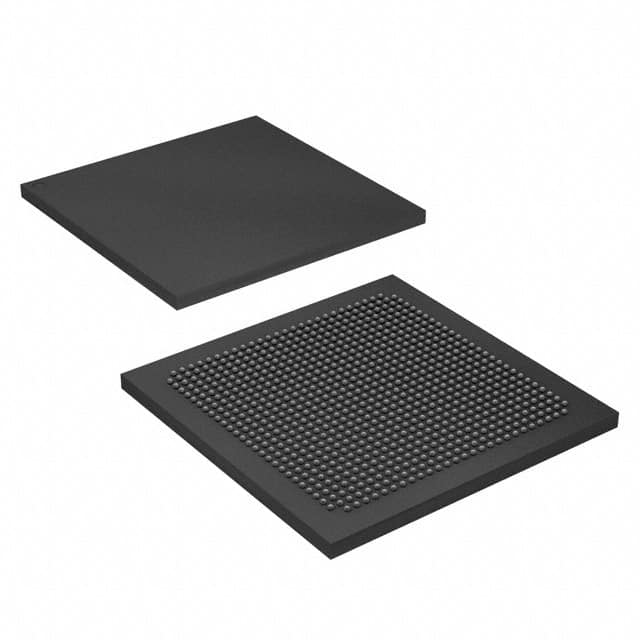5SGSMD3E2H29C1N
Product Overview
Category
The 5SGSMD3E2H29C1N belongs to the category of Field Programmable Gate Arrays (FPGAs).
Use
FPGAs are integrated circuits that can be programmed and reprogrammed to perform various digital functions. The 5SGSMD3E2H29C1N is specifically designed for high-performance applications.
Characteristics
- High-speed processing capabilities
- Configurable logic blocks
- On-chip memory
- Flexible I/O interfaces
- Low power consumption
Package
The 5SGSMD3E2H29C1N is available in a compact and durable package, ensuring easy integration into electronic systems.
Essence
The essence of the 5SGSMD3E2H29C1N lies in its ability to provide customizable digital logic functions, enabling designers to implement complex algorithms and systems on a single chip.
Packaging/Quantity
The 5SGSMD3E2H29C1N is typically packaged individually and is available in various quantities depending on the requirements of the user.
Specifications
- FPGA Family: Stratix V
- Logic Elements: 220,000
- Embedded Memory: 8,848 Kbits
- Maximum User I/Os: 622
- Maximum Differential I/O Pairs: 311
- Operating Voltage: 1.0V
- Operating Temperature Range: -40°C to 100°C
Detailed Pin Configuration
The detailed pin configuration of the 5SGSMD3E2H29C1N can be found in the product datasheet provided by the manufacturer. It includes information about the specific functions and connections of each pin.
Functional Features
- High-performance processing capabilities
- Support for advanced digital signal processing algorithms
- Configurable I/O interfaces for versatile connectivity options
- On-chip memory for efficient data storage and retrieval
- Built-in security features to protect sensitive information
Advantages and Disadvantages
Advantages
- Flexibility: FPGAs can be reprogrammed, allowing for design changes without the need for hardware modifications.
- High Performance: The 5SGSMD3E2H29C1N offers fast processing speeds and efficient resource utilization.
- Integration: It enables the integration of multiple functions on a single chip, reducing the need for additional components.
Disadvantages
- Complexity: Designing and programming FPGAs can be challenging and time-consuming.
- Power Consumption: FPGAs tend to consume more power compared to other integrated circuits.
- Cost: FPGAs can be relatively expensive compared to alternative solutions for certain applications.
Working Principles
The 5SGSMD3E2H29C1N operates based on the principles of reconfigurable logic. It consists of configurable logic blocks (CLBs), interconnects, and embedded memory elements. The CLBs can be programmed to implement various digital functions, while the interconnects provide the necessary connections between different components. The embedded memory allows for efficient data storage and retrieval during operation.
Detailed Application Field Plans
The 5SGSMD3E2H29C1N finds applications in various fields, including:
- Telecommunications: Used in high-speed data transmission systems and network infrastructure equipment.
- Aerospace and Defense: Employed in radar systems, avionics, and secure communication systems.
- Industrial Automation: Utilized in control systems, robotics, and machine vision applications.
- Medical Devices: Integrated into medical imaging systems, patient monitoring devices, and diagnostic equipment.
- Automotive: Applied in advanced driver-assistance systems (ADAS), infotainment systems, and engine control units.
Detailed and Complete Alternative Models
- Xilinx Virtex UltraScale+: Offers similar high-performance capabilities with advanced DSP features.
- Intel Cyclone 10 GX: Provides a cost-effective solution for mid-range FPGA applications.
- Lattice ECP5: Focuses on low-power consumption and small form factor designs.
- Microsemi PolarFire: Designed for applications requiring high reliability and security features.
These alternative models offer different trade-offs in terms of performance, power consumption, and cost, allowing designers to choose the most suitable option for their specific requirements.
Word count: 550 words
Senaraikan 10 soalan dan jawapan biasa yang berkaitan dengan aplikasi 5SGSMD3E2H29C1N dalam penyelesaian teknikal
Sure! Here are 10 common questions and answers related to the application of 5SGSMD3E2H29C1N in technical solutions:
Q1: What is the 5SGSMD3E2H29C1N? A1: The 5SGSMD3E2H29C1N is a specific model of Field-Programmable Gate Array (FPGA) manufactured by Intel.
Q2: What are the key features of the 5SGSMD3E2H29C1N? A2: The 5SGSMD3E2H29C1N offers high-performance processing capabilities, low power consumption, large capacity for logic and memory, and support for various communication protocols.
Q3: In what technical solutions can the 5SGSMD3E2H29C1N be used? A3: The 5SGSMD3E2H29C1N can be used in a wide range of applications such as telecommunications, data centers, industrial automation, aerospace, defense, and scientific research.
Q4: How does the 5SGSMD3E2H29C1N contribute to improving performance in technical solutions? A4: The 5SGSMD3E2H29C1N provides high-speed processing capabilities, parallel computing, and customizable hardware acceleration, which can significantly enhance the performance of various applications.
Q5: Can the 5SGSMD3E2H29C1N be programmed? A5: Yes, the 5SGSMD3E2H29C1N is a programmable device. It can be configured and reconfigured using Hardware Description Languages (HDLs) like VHDL or Verilog.
Q6: What tools are available for programming the 5SGSMD3E2H29C1N? A6: Intel provides Quartus Prime software, which is a comprehensive development environment for designing, simulating, and programming FPGAs like the 5SGSMD3E2H29C1N.
Q7: Can the 5SGSMD3E2H29C1N interface with other components or devices? A7: Yes, the 5SGSMD3E2H29C1N supports various communication interfaces such as PCIe, Ethernet, USB, I2C, SPI, and more, allowing it to interface with other components or devices in a system.
Q8: What are the power requirements for the 5SGSMD3E2H29C1N? A8: The power requirements for the 5SGSMD3E2H29C1N depend on the specific implementation and configuration. It typically operates at low voltages and consumes relatively low power compared to traditional processors.
Q9: Are there any limitations or considerations when using the 5SGSMD3E2H29C1N? A9: Some considerations include the need for expertise in FPGA programming, potential design complexity, and the requirement for proper thermal management due to increased power density.
Q10: Where can I find additional resources or support for working with the 5SGSMD3E2H29C1N? A10: Intel provides documentation, application notes, reference designs, and an online community forum where users can find additional resources and seek support for working with the 5SGSMD3E2H29C1N.


